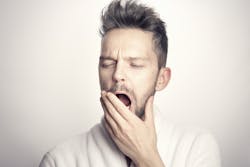Natural light and circadian expert blasts daylight savings
If you’ve been feeling off-kilter ever since you turned the clocks ahead recently, that would not surprise one of the world’s leading advocates for natural light and circadian health.
For the built environment — the default focus of LEDs Magazine — the University of Munich’s Till Roenneberg is a strong architectural proponent of channeling daylight down from rooftops. We took note of this in our recent health and wellbeing feature.
The notion of using mirrors and optics to distribute natural light throughout office buildings is a manifestation of Roenneberg’s high regard for human circadian balance. It reflects his concern that, since life moved largely indoors less than 200 years ago, humans have defied the importance of the world’s most influential light source — the sun.
Many millions of years ago, the pattern of sunrise and sunset, and all the regularly varying intensities and spectra that transpire in between, literally started getting into the heads of humans. Daily natural light patterns, perhaps more than any other factor, have set the brain’s master circadian clock — known as the suprachiasmatic nuclei — which gates the necessary on and off cycles of billions of other clocks throughout the body’s organs and tissues.
As we noted in our recent feature, mess with that light-centric, 24-hour rhythm, and you’re asking for trouble. Unbalanced circadian durations have been linked to all manner of physical and mental maladies, from diabetes to poor sleep, cancer, and neurological disorders.
Yet messing with it is what we potentially do every day and night that we subject ourselves to constant levels of electric lighting or fail to go outdoors and receive a healthy dose of daylight to instigate circadian entrainment. Although artificial LED lighting can indeed be programmed to mimic the sun’s patterns, there is no light like natural light when it comes to nurturing our health.
Many experts agree about that. Certainly Roenneberg does.
“Living creatures have a body clock that creates daily rhythms,” Roenneberg wrote in a 2019 paper in the Journal of Biological Rhythms, one of many articles he has written on the subject. “This body clock organizes our biology, such as when we eat and sleep, when we can run fastest, and when our brain works at its best (Young, 2000). The body clock must be made to match our 24-h environment. In a ‘natural day,’ the light of the sun and darkness at night are the main signals that adjust the timing of our body clock. This is true even within cities, where we experience less outdoor light during the day and more electric light during the night. Electric light can also adjust body clocks to match 24-h days, but natural daylight is usually 100 to 1000 times brighter than indoor light (Wright et al., 2013) and therefore more effective. We must recognize the important role of light in shaping our daily behavior and the important role of our body clock in maintaining our health and well-being.”
Roenneberg, who is professor emeritus at Ludwig Maximilian University of Munich’s Institute for Medical Psychology, is so adamant about respecting the sun’s patterns that he wants to abolish Daylight Savings. He maintains that the semiannual ritual of setting our clocks ahead and behind by a mere one hour comes with serious health ramifications. He described these in the 2019 article, which was titled “Why Should We Abolish Daylight Saving Time?,” and co-authored by the University of Basel’s Anna Wirz-Justice, the University of Surrey’s Debra J. Skene, and others.
While DST can have benefits such as providing for more after-work daylight, the disadvantages far outweigh the upside, he wrote.
“DST also creates problems, which can be either short-term (acute) or long-term (chronic),” Roenneberg noted. “The first days after the sudden switch to DST in spring cause acute effects including shorter sleep duration (Barnes and Wagner, 2009; Harrison, 2013), worse performance (Gaski and Sagarin, 2011), and worse health; heart attacks are, for example, higher during that time compared with other weeks (Janszky and Ljung, 2008; Manfredini et al., 2018), and there may be more traffic accidents (Carey and Sarma, 2017; Coren, 1996a, 1996b; Hicks et al., 1983; Lahti et al., 2010). The chronic effects may last throughout the months of DST because in many people, social clocks and body clocks remain set to different times, as explained in the previous section; the body clock does not adjust to DST social clock time even over months (Hadlow et al., 2014).”
So if you’re currently feeling listless or worse, maybe, just maybe, it’s the rude awakening of DST. Then again, we hear that there’s some novel virus about. Hopefully it’s not that.
Embrace the morning tomorrow, but try not to sleep in. Like DST, it’s not good for the body clock. You could reach instead for some stimulating artificial light. Better yet, step outdoors and get things ticking with a good dose of the natural version.
MARK HALPER is a contributing editor for LEDs Magazine, and an energy, technology, and business journalist ([email protected]).
For up-to-the-minute LED and SSL updates, why not follow us on Twitter? You’ll find curated content and commentary, as well as information on industry events, webcasts, and surveys on our LinkedIn Company Page and our Facebook page.

Mark Halper | Contributing Editor, LEDs Magazine, and Business/Energy/Technology Journalist
Mark Halper is a freelance business, technology, and science journalist who covers everything from media moguls to subatomic particles. Halper has written from locations around the world for TIME Magazine, Fortune, Forbes, the New York Times, the Financial Times, the Guardian, CBS, Wired, and many others. A US citizen living in Britain, he cut his journalism teeth cutting and pasting copy for an English-language daily newspaper in Mexico City. Halper has a BA in history from Cornell University.


![The DesignLights Consortium continues to make progress in shifting outdoor lighting products and implementation practices toward a more restrained and thoughtful strategy. [Image does not represent a DLC qualified fixture.] The DesignLights Consortium continues to make progress in shifting outdoor lighting products and implementation practices toward a more restrained and thoughtful strategy. [Image does not represent a DLC qualified fixture.]](https://img.ledsmagazine.com/files/base/ebm/leds/image/2024/08/66be810888ae93f656446f61-dreamstime_m_265700653.png?auto=format,compress&fit=&q=45&h=139&height=139&w=250&width=250)


